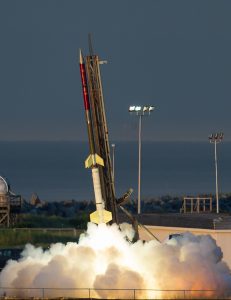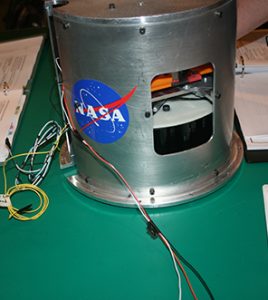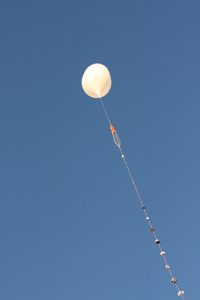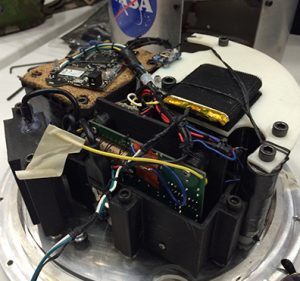2015-2016 ACC Space Grant
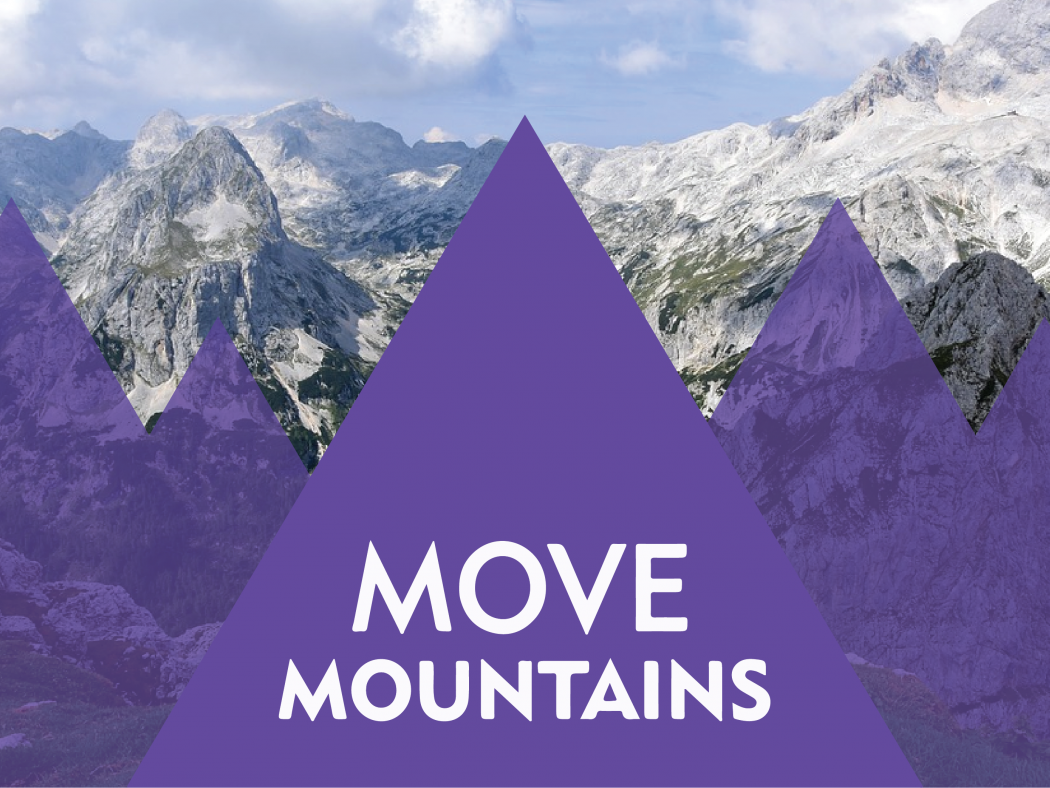
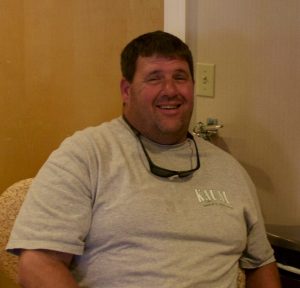 Chris Littlefield
Chris Littlefield
I am a non-traditional student. I have returned to school after spending 25 years raising a family and working in the corporate world. I am old enough to have seen the last moon mission, Apollo 17. The last humans to leave low earth orbit. Privatization of some space flight has led to an explosion in Aerospace companies. According to the Colorado Space Coalition there are more than 400 private aerospace companies in Colorado, supplying and developing commercial, military and government space applications. 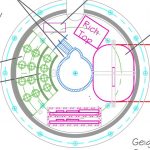
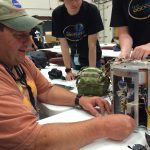 I am blessed with the opportunity to return to school at such a time in history. My goal in returning to school is get a job that enables me to participate in the rejuvenated push to space. Participation in the RockSatC program has allowed me to be part of a diverse team of students and faculty from around the Denver metro area. We came together and with
I am blessed with the opportunity to return to school at such a time in history. My goal in returning to school is get a job that enables me to participate in the rejuvenated push to space. Participation in the RockSatC program has allowed me to be part of a diverse team of students and faculty from around the Denver metro area. We came together and with 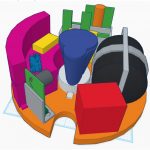 much work and gnashing of teeth built a scientific payload that returned valuable science. My job on the team was lead Structural Engineer. I was able to take on the task of understanding the science group’s requirements, and design structures that would accomplish the required science. This project has allowed me to take a basic understanding of CAD and transform that into 3D structures that performed science in space.
much work and gnashing of teeth built a scientific payload that returned valuable science. My job on the team was lead Structural Engineer. I was able to take on the task of understanding the science group’s requirements, and design structures that would accomplish the required science. This project has allowed me to take a basic understanding of CAD and transform that into 3D structures that performed science in space. 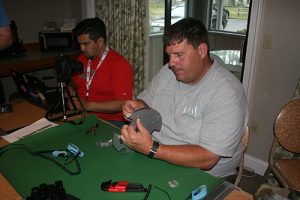 The program is a challenge. It will test you in many unexpected ways. The people on the team became my friends and there are times where you spend more time at school working on the payload then you do with your family and studies. I am pursuing a B.S. in Aviation and Aerospace science at Metropolitan State University where I hope to continue launching things to space. It is possible to accomplish your dreams. If you don’t do it this year you will be one year older when you do. Warren Miller. -Chris Littlefield
The program is a challenge. It will test you in many unexpected ways. The people on the team became my friends and there are times where you spend more time at school working on the payload then you do with your family and studies. I am pursuing a B.S. in Aviation and Aerospace science at Metropolitan State University where I hope to continue launching things to space. It is possible to accomplish your dreams. If you don’t do it this year you will be one year older when you do. Warren Miller. -Chris Littlefield
Jamie Principato
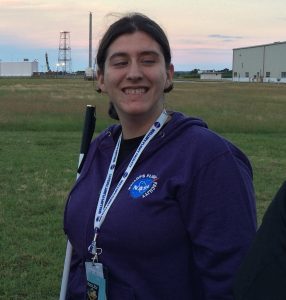 Sometimes, the things you believe you are least qualified to do are the things you will learn and grow the most from doing. When ACC first established a Space Grant team, I was anything but qualified to take on such a project. I still wasn’t completely sure of my major, I hadn’t yet successfully completed a Physics course and I didn’t know the first thing about Space or the stratosphere or engineering or really how to be a part of a research team. But I knew it all sounded exciting.
Sometimes, the things you believe you are least qualified to do are the things you will learn and grow the most from doing. When ACC first established a Space Grant team, I was anything but qualified to take on such a project. I still wasn’t completely sure of my major, I hadn’t yet successfully completed a Physics course and I didn’t know the first thing about Space or the stratosphere or engineering or really how to be a part of a research team. But I knew it all sounded exciting. 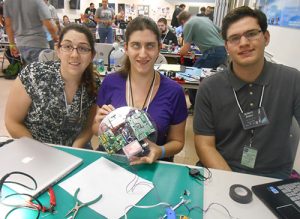 It started, for me, the first time I was late to Physics class. It was raining and I was running through Downtown Littleton to try to get there before the end of that inevitable pop quiz I couldn’t afford to fail. Luckily for me, my professor was making a lengthy announcement at the beginning of class that day. I peered through the glass window on the door and saw a NASA logo on the projector screen, and a small rocket igniting on a launch pad. When a classmate opened the door for me, the first thing I heard was my professor explaining “you’ll get to work on some sophisticated projects and you might even be able to send them into space, so if you’re interested, just-” ... and I couldn’t contain myself. While still walking to my seat, soaked from the rain and out of breath, my hand shot into the air and I blurted out “I’m interested!”
It started, for me, the first time I was late to Physics class. It was raining and I was running through Downtown Littleton to try to get there before the end of that inevitable pop quiz I couldn’t afford to fail. Luckily for me, my professor was making a lengthy announcement at the beginning of class that day. I peered through the glass window on the door and saw a NASA logo on the projector screen, and a small rocket igniting on a launch pad. When a classmate opened the door for me, the first thing I heard was my professor explaining “you’ll get to work on some sophisticated projects and you might even be able to send them into space, so if you’re interested, just-” ... and I couldn’t contain myself. While still walking to my seat, soaked from the rain and out of breath, my hand shot into the air and I blurted out “I’m interested!” 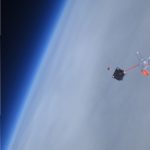 And from that impulsive leap, my excitement and enthusiasm grew. I was one of the first people to join the first team, and there was so much to learn, but we had so much support and opportunity to facilitate that learning. Over the winter break, I attended a workshop with my professor, and I learned how to use a soldering iron and design and test circuits that were intended for a variety of purposes from turning on lights and heaters to getting information about the environment through delicate little sensors. I learned how to program the computer chip that would control all of these circuits and sensors, too, and make it possible for us to understand the information they’re collecting. These were the basic skills we would need to design and build our own payload later that spring. Next, it was time to come up with an idea. We knew a little, now, about the environment to which we would be sending our payload. It would be flying on a high altitude weather balloon, through the very thin layer of the atmosphere above the clouds, but below Space, called the Stratosphere.
And from that impulsive leap, my excitement and enthusiasm grew. I was one of the first people to join the first team, and there was so much to learn, but we had so much support and opportunity to facilitate that learning. Over the winter break, I attended a workshop with my professor, and I learned how to use a soldering iron and design and test circuits that were intended for a variety of purposes from turning on lights and heaters to getting information about the environment through delicate little sensors. I learned how to program the computer chip that would control all of these circuits and sensors, too, and make it possible for us to understand the information they’re collecting. These were the basic skills we would need to design and build our own payload later that spring. Next, it was time to come up with an idea. We knew a little, now, about the environment to which we would be sending our payload. It would be flying on a high altitude weather balloon, through the very thin layer of the atmosphere above the clouds, but below Space, called the Stratosphere. 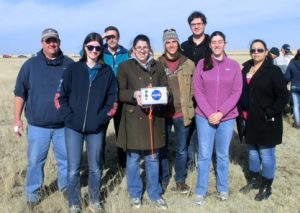 We would reach an altitude of nearly 100,000 feet, where the sky above us would be black instead of blue, and we would stay in the air for a few hours. There are a lot of things you can observe at that altitude that are much harder to study from the ground, and the first thing that came to mind for me was cosmic radiation. Most of the radiation that bombards our planet from outer space is blocked by the many layers of our atmosphere before it can reach us on the ground, but in the stratosphere, there is much less in the way to block cosmic rays. I wanted to see what this higher level of radiation was like. And more than that, I wanted to thoroughly understand it. So I started doing research and learning about all the many ways there are to observe radiation, and believe me, there were more than I expected. I started discussing my questions and ideas with my professors and my newly established team, and before long, we had settled on a multimodal radiation study as our first project. We wanted to use three very different observation methods, because this would allow us to understand many different properties of cosmic radiation while practicing a lot of hands-on STEM skills.
We would reach an altitude of nearly 100,000 feet, where the sky above us would be black instead of blue, and we would stay in the air for a few hours. There are a lot of things you can observe at that altitude that are much harder to study from the ground, and the first thing that came to mind for me was cosmic radiation. Most of the radiation that bombards our planet from outer space is blocked by the many layers of our atmosphere before it can reach us on the ground, but in the stratosphere, there is much less in the way to block cosmic rays. I wanted to see what this higher level of radiation was like. And more than that, I wanted to thoroughly understand it. So I started doing research and learning about all the many ways there are to observe radiation, and believe me, there were more than I expected. I started discussing my questions and ideas with my professors and my newly established team, and before long, we had settled on a multimodal radiation study as our first project. We wanted to use three very different observation methods, because this would allow us to understand many different properties of cosmic radiation while practicing a lot of hands-on STEM skills. 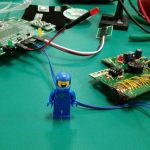 We wanted to build a Geiger counter, which operates by interrupting a circuit when an ionized particle passes through a tube of gas, a dosimeter, which is like a piece of thin film that permanently darkens in places where it is hit by radiation, and (my personal favorite) a cloud chamber. A cloud chamber is basically a container of supersaturated gas, like a cloud in the sky, that condensates when a charged particle passes through it. If you record video of the inside of the container, or just look with your eyes, you’ll see wispy trails of condensation moving through the gas like tiny snakes through water. These trails are evidence of tiny subatomic particles from cosmic radiation moving through the container!
We wanted to build a Geiger counter, which operates by interrupting a circuit when an ionized particle passes through a tube of gas, a dosimeter, which is like a piece of thin film that permanently darkens in places where it is hit by radiation, and (my personal favorite) a cloud chamber. A cloud chamber is basically a container of supersaturated gas, like a cloud in the sky, that condensates when a charged particle passes through it. If you record video of the inside of the container, or just look with your eyes, you’ll see wispy trails of condensation moving through the gas like tiny snakes through water. These trails are evidence of tiny subatomic particles from cosmic radiation moving through the container! 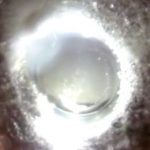 It took a lot of time, in and out of the lab, to integrate these three ideas into a single payload that met all the size and weight and budget restrictions we had to consider. It was a semester-long project, and while in the beginning we were only meeting once a week, we soon found ourselves getting together in smaller groups throughout the week to work on various parts of the project, and reserving our weekly full-team meetings for things we needed to discuss or do with everyone. We learned quickly how to organize ourselves and delegate responsibilities to each other, how to set and stick to schedules and keep everyone up to date on new information or changes to plans and ideas. Our professors were amazing. They stood back and let us find the routine that worked best for us as a group, and really stretch or creativity and try new things, even if it looked like we would fail, but they were always there in a pinch if we had a question or needed help with something we just didn’t understand. They played the role of facilitators more than instructors, and made sure we had everything we needed to learn as much as we could.
It took a lot of time, in and out of the lab, to integrate these three ideas into a single payload that met all the size and weight and budget restrictions we had to consider. It was a semester-long project, and while in the beginning we were only meeting once a week, we soon found ourselves getting together in smaller groups throughout the week to work on various parts of the project, and reserving our weekly full-team meetings for things we needed to discuss or do with everyone. We learned quickly how to organize ourselves and delegate responsibilities to each other, how to set and stick to schedules and keep everyone up to date on new information or changes to plans and ideas. Our professors were amazing. They stood back and let us find the routine that worked best for us as a group, and really stretch or creativity and try new things, even if it looked like we would fail, but they were always there in a pinch if we had a question or needed help with something we just didn’t understand. They played the role of facilitators more than instructors, and made sure we had everything we needed to learn as much as we could. 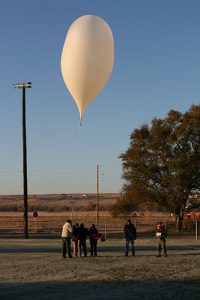 When the payload was finished and it was finally launch day, I don’t think I could have been more excited. We all left ACC together in one van, well before the crack of dawn, and drove out to the East where there would be less water and fewer mountains to get in the way of a safe launch and landing. There were lots of other teams there, all to share the same balloon, and it was interesting to talk to them and learn about their projects and the ideas they had been investigating all semester long. Every school seemed to do things a little differently in terms of how their team operated, and it gave me a sense of pride in my own school to talk about how our lab worked and what we had accomplished so far. We even met another team of students who were studying radiation, and were later able to share data with them to make both our projects even better. Finally, when the balloon lifted off, my heart lifted with it. I could barely believe I was doing science at the edge of space, that this thing flying up into the clouds was something I dreamed up and built with the help of my friends, that I really could ask a question about the universe and then go and find the answer without waiting for someone more “qualified” to give it to me or tell me I have the right to look. And I knew then, for me, that this was only the beginning. -Jamie Principato
When the payload was finished and it was finally launch day, I don’t think I could have been more excited. We all left ACC together in one van, well before the crack of dawn, and drove out to the East where there would be less water and fewer mountains to get in the way of a safe launch and landing. There were lots of other teams there, all to share the same balloon, and it was interesting to talk to them and learn about their projects and the ideas they had been investigating all semester long. Every school seemed to do things a little differently in terms of how their team operated, and it gave me a sense of pride in my own school to talk about how our lab worked and what we had accomplished so far. We even met another team of students who were studying radiation, and were later able to share data with them to make both our projects even better. Finally, when the balloon lifted off, my heart lifted with it. I could barely believe I was doing science at the edge of space, that this thing flying up into the clouds was something I dreamed up and built with the help of my friends, that I really could ask a question about the universe and then go and find the answer without waiting for someone more “qualified” to give it to me or tell me I have the right to look. And I knew then, for me, that this was only the beginning. -Jamie Principato
David Colclazier
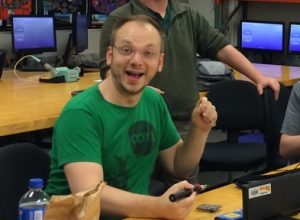 Hi! I'm David Colclazier, one of the project managers for the RockSat-C 2016 program sponsored by the Colorado Space Grant Consortium at Arapahoe Community College. With how little awareness exists around the program, I felt it prudent to jot down a few of my thoughts about my experiences now that it's said and done. Well, not quite... the launch went off without a hitch, and I now spend my free time performing image analysis (what?!?) on pictures we received from our Ring Imaging Cherynkov detector (who?!?!), locating and determining the makeup of charged particle impacts we picked up with a hacked GoPro. If you had told me a month ago I would be doing this, loving it, and most importantly, succeeding, I would have laughed at you and told you I knew absolutely nothing about Ring-Like Cherry Detectors or image analysis or anything of the sort.
Hi! I'm David Colclazier, one of the project managers for the RockSat-C 2016 program sponsored by the Colorado Space Grant Consortium at Arapahoe Community College. With how little awareness exists around the program, I felt it prudent to jot down a few of my thoughts about my experiences now that it's said and done. Well, not quite... the launch went off without a hitch, and I now spend my free time performing image analysis (what?!?) on pictures we received from our Ring Imaging Cherynkov detector (who?!?!), locating and determining the makeup of charged particle impacts we picked up with a hacked GoPro. If you had told me a month ago I would be doing this, loving it, and most importantly, succeeding, I would have laughed at you and told you I knew absolutely nothing about Ring-Like Cherry Detectors or image analysis or anything of the sort. 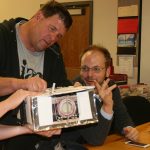 The experiences I had... the opportunities for learning, social interaction, problem solving, time-management, confidence building, and general handyman growth are infinite. To start with absolutely nothing, tap into a rusty imagination to create a pool of ideas with a group of other folks who have a much better imagination than I... To narrow down the validity of those choices to a single idea and see that idea spring into existance... It's surreal. The experience opened a somewhat hidden door, as well... I now have similar personal projects I'm working on I never would have thought I had the capability of completing if I hadn't participated. I'm building an RC lawnmower, an automatic hydroponic gardening monitoring system, my own RICH detecter because I now find the science freakin' awesome… The most common thing I hear from folks who are considering participating in a Space Grant program is either "I have nothing to offer the group," or "I have no experience with {x}.." I beg to differ. I felt the same way before, and now think it's one of the silliest reasons not to participate, but rather one of the best reasons you should. Following is a list of skills I had little or no knowledge of prior to participating in the COSGC program:
The experiences I had... the opportunities for learning, social interaction, problem solving, time-management, confidence building, and general handyman growth are infinite. To start with absolutely nothing, tap into a rusty imagination to create a pool of ideas with a group of other folks who have a much better imagination than I... To narrow down the validity of those choices to a single idea and see that idea spring into existance... It's surreal. The experience opened a somewhat hidden door, as well... I now have similar personal projects I'm working on I never would have thought I had the capability of completing if I hadn't participated. I'm building an RC lawnmower, an automatic hydroponic gardening monitoring system, my own RICH detecter because I now find the science freakin' awesome… The most common thing I hear from folks who are considering participating in a Space Grant program is either "I have nothing to offer the group," or "I have no experience with {x}.." I beg to differ. I felt the same way before, and now think it's one of the silliest reasons not to participate, but rather one of the best reasons you should. Following is a list of skills I had little or no knowledge of prior to participating in the COSGC program:
- Embedded microcontroller programming (arduino, netduion, edison)
- 3d printing with multiple materials and extruders (I'd 3d printed before, but knew very little compared to now)
- 3d modeling and prototyping with SolidWorks and AutoCAD <--- THIS IS HUGE! Electronics - circuit design and testing, noise management
- Hacking (the electronic kind - tear apart a gopro, design and print parts to fit inside, put your parts in, put it back together, it still works!)
- Parallel programming
- Going from about a 3 on the 'handy' chart to a '7' or '8'
- RC communications
- The names and purpose of countless tools, pieces of hardware, and other gizmos I'd never seen before (ALSO HUGE, lol...)
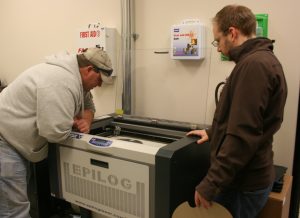 I am now brimming with the confidence that I will fly through the rest of my Aerospace Engineering degree at CU Boulder with not only a head-start on those who have not participated, but with the ease of mind that transitioning from the theoretical classroom setting to the hands-on application of everything I've learned will be cake.
I am now brimming with the confidence that I will fly through the rest of my Aerospace Engineering degree at CU Boulder with not only a head-start on those who have not participated, but with the ease of mind that transitioning from the theoretical classroom setting to the hands-on application of everything I've learned will be cake. 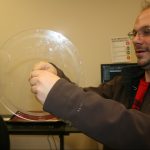
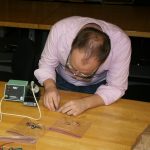 It won't be easy.... "space is hard." You will lose sleep, you will fall behind, and you will have setbacks. I've learned where my limits lie from a stress management standpoint; no more weeks with less than 8 hours of aggregate sleep! Still, participating was nothing less than fantastic, I'd do it all over again in a heartbeat, and I guarantee you'll feel the same way. I quote a new shirt I received for my birthday: "The Only Reason I Became An Aerospace Engineer Was So I Could Build My Own Starship Enterprise.” -David Colclazier
It won't be easy.... "space is hard." You will lose sleep, you will fall behind, and you will have setbacks. I've learned where my limits lie from a stress management standpoint; no more weeks with less than 8 hours of aggregate sleep! Still, participating was nothing less than fantastic, I'd do it all over again in a heartbeat, and I guarantee you'll feel the same way. I quote a new shirt I received for my birthday: "The Only Reason I Became An Aerospace Engineer Was So I Could Build My Own Starship Enterprise.” -David Colclazier
Joe Hamvas
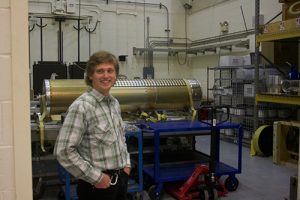 It’s all about what they don’t teach you in class. My name is Joe Hamvas, and I was in the Colorado Space Grant program for 3 semesters at ACC while I got an Associate of Science in Math degree. I’ve now transferred to CU Denver for Mechanical Engineering. Although I was able to apply some of the things I had learned in class to the RockSat- C Project, I learned the most from creating power point presentations and working with teammates. Often Engineering is misunderstood as just doing math all day, but this project taught me vital people skills.
It’s all about what they don’t teach you in class. My name is Joe Hamvas, and I was in the Colorado Space Grant program for 3 semesters at ACC while I got an Associate of Science in Math degree. I’ve now transferred to CU Denver for Mechanical Engineering. Although I was able to apply some of the things I had learned in class to the RockSat- C Project, I learned the most from creating power point presentations and working with teammates. Often Engineering is misunderstood as just doing math all day, but this project taught me vital people skills. 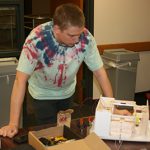
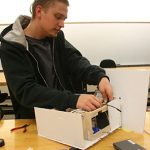 Without “mundane” documentation, our rocket payload never would have launched. The things I learned in RockSat-C were skills I can use in the workforce and in real life projects. The skills students learn here are more valuable than a degree, and, as icing on the cake, I even got to use some of the things I learned in class on the project. There is no feeling like watching something you worked on get launched into space by NASA. - Joe Hamvas
Without “mundane” documentation, our rocket payload never would have launched. The things I learned in RockSat-C were skills I can use in the workforce and in real life projects. The skills students learn here are more valuable than a degree, and, as icing on the cake, I even got to use some of the things I learned in class on the project. There is no feeling like watching something you worked on get launched into space by NASA. - Joe Hamvas
Lawrence Perkins
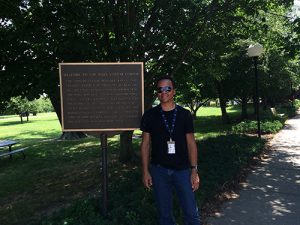 My path to space and self discovery started with a poster on the wall. I started at ACC as a part time student pursuing a path towards transferring credits to the electrical engineering program at UCD. At the time I wasn't confident that I was good enough to have an engineering career. I knew I could do the work; however, I just didn't have the confidence in my abilities to apply my self towards anything that could better myself.
My path to space and self discovery started with a poster on the wall. I started at ACC as a part time student pursuing a path towards transferring credits to the electrical engineering program at UCD. At the time I wasn't confident that I was good enough to have an engineering career. I knew I could do the work; however, I just didn't have the confidence in my abilities to apply my self towards anything that could better myself. 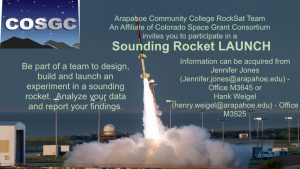 One of the first weeks of the beginning of the fall semester of 2015, I stumbled upon a poster for the RockSat team that was forming at ACC. I was intrigued at what I read but had to get to class. As I continued on with my week, my Trigonometry professor had a bit of special news for us. She presented to the class slides of the DemoSat and RockSat programs and explained what they were. I decided to investigate further thinking that I would not be a good fit for such a project.
One of the first weeks of the beginning of the fall semester of 2015, I stumbled upon a poster for the RockSat team that was forming at ACC. I was intrigued at what I read but had to get to class. As I continued on with my week, my Trigonometry professor had a bit of special news for us. She presented to the class slides of the DemoSat and RockSat programs and explained what they were. I decided to investigate further thinking that I would not be a good fit for such a project. 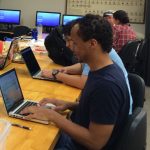 After attending the first meetings for both the DemoSat and the RockSat missions, I knew I wanted to be a part of the teams and contribute, even if that meant just keeping track of the budget and what we needed to order. So I did, by designing a spread sheet that tracked items that were ordered and/or in stock. Then we needed to make electrical schematics that were easy to understand, so I did that as well. Before I knew it, I was making contributions all areas of the projects from just giving sound advice to designing and building. Best of all, I noticed that I was becoming more comfortable making said contributions! I felt confident performing as an engineer!
After attending the first meetings for both the DemoSat and the RockSat missions, I knew I wanted to be a part of the teams and contribute, even if that meant just keeping track of the budget and what we needed to order. So I did, by designing a spread sheet that tracked items that were ordered and/or in stock. Then we needed to make electrical schematics that were easy to understand, so I did that as well. Before I knew it, I was making contributions all areas of the projects from just giving sound advice to designing and building. Best of all, I noticed that I was becoming more comfortable making said contributions! I felt confident performing as an engineer! 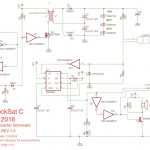 One day, during a RockSat meeting, there was a proposal to make a RICH (Ring Imaging Cherenkov) detector using a camera. There were many cameras that we were trying to choose from, one of which was to use a GoPro. Before, I would have made a suggestion of which camera to use and that would be the end of it. This time, I tried something different called persistence. I was confident that I could make a GoPro perform the task we needed it to, so I kept pushing my idea until we decided it was the best for the room, weight, power, and budget. I stood up for my idea and provided constructive ways to build the RICH detector the team needed. Our RICH detector flew on a DemoSat flight and our RockSat flight and is still functional to this day. I helped the team achieve designing a low cost functioning RICH detector and proved its function in space! This is something that I could not have done without the added confidence in myself that being a part of these teams have given me as the lead Electrical Engineer.
One day, during a RockSat meeting, there was a proposal to make a RICH (Ring Imaging Cherenkov) detector using a camera. There were many cameras that we were trying to choose from, one of which was to use a GoPro. Before, I would have made a suggestion of which camera to use and that would be the end of it. This time, I tried something different called persistence. I was confident that I could make a GoPro perform the task we needed it to, so I kept pushing my idea until we decided it was the best for the room, weight, power, and budget. I stood up for my idea and provided constructive ways to build the RICH detector the team needed. Our RICH detector flew on a DemoSat flight and our RockSat flight and is still functional to this day. I helped the team achieve designing a low cost functioning RICH detector and proved its function in space! This is something that I could not have done without the added confidence in myself that being a part of these teams have given me as the lead Electrical Engineer. 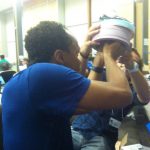 Currently I'm leading a project for the Colorado Space Grant called the Eclipse Project. We'll have the opportunity to study the solar eclipse on August 21, 2017 via high altitude balloon. Just one year ago, not only was I unaware of Space Grants existence, but I was unaware of the true passion I hold to become engineer. Now the only question is “Do I become and Electrical Engineer or an Aerospace Engineer?” Maybe both... - Lawrence Perkins
Currently I'm leading a project for the Colorado Space Grant called the Eclipse Project. We'll have the opportunity to study the solar eclipse on August 21, 2017 via high altitude balloon. Just one year ago, not only was I unaware of Space Grants existence, but I was unaware of the true passion I hold to become engineer. Now the only question is “Do I become and Electrical Engineer or an Aerospace Engineer?” Maybe both... - Lawrence Perkins


